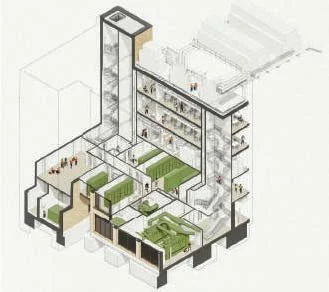The British Museum - Energy Centre Programme
The British Museum - Energy Centre Programme
We have had a long and successful relationship with the British Museum, working on a wide variety of projects as framework consultants. This has ranged from small, specific projects advising on displaying exhibits to gallery refurbishments and wide-ranging strategic advice.
Despite the prominence of the Bloomsbury estate and its collection, the museum faces challenges in its infrastructure. This major project will end the museum’s reliance on gas fossil fuels for heating and deliver a new low-carbon and energy efficient heating system (and associated electrical infrastructure), paving the way to a net zero future. Despite the positive impact they will have on the entire estate, these new buildings only take up 1.8% of the Museum site’s footprint.
Acting as Civil and Structural engineers, we have been advising on all stages of the Programme. Our work has involved the design of three new buildings in the perimeter areas of the site to house this infrastructure, as well as the complex task of coordinating the redistribution of services through the labyrinth of different areas of historic fabric.
The principal building is in the southeast corner of the Museum, which currently houses temporary portacabins. The East End Road Building will house all-electric water and air source heat pump technology and will consist of two floors, featuring a 250m² basement and a total floor area of 700m². The facility will be built on a foundation of piled structures, whilst its internal space is designed as a shell, with future plans to incorporate installations such as sprinkler tanks, pumps, generators, and a substation.
Designed to achieve a BREEAM Excellent rating, it will result in an estimated net saving of 1,700 tonnes of CO2 annually and deliver estate-wide carbon reductions of 45%, while building on only 1.8% of the site’s footprint.
Client: The British Museum
Architects: Wright & Wright
IMPACT
Path to net zero
The new energy-efficient heating and cooling systems installed through the Energy Centre Programme will:
End the Museum's reliance on gas fossil fuels for its primary heating system.
Eliminate the direct carbon emissions produced by existing gas boilers.
Result in an estimated annual net saving of 1,700 tonnes of carbon dioxide.
Provide capacity for and enable the rollout of more energy efficient infrastructure across the Museum during the rest of the Masterplan and beyond.
Protecting the Museum and the collection
Updating the ageing infrastructure will reduce fire and flood risk, and dramatically improve the Museum's capacity to deliver energy where it is needed.
The new Energy Centre buildings will be designed to integrate seamlessly with and preserve the Museum's architecture.
Museum infrastructure maintenance will be improved and streamlined, with equipment that is rationalised, more accessible and easier to maintain.
Significant cost savings long term
Investing in sustainable infrastructure now will result in significant savings in the long term.
It will provide the Museum with increased financial stability, resilience, and value for money by reducing operational costs and avoiding increasing maintenance costs for outdated infrastructure.


